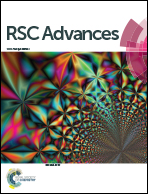A selective fluorescent probe based on bis-Schiff base for “turn-on” detection of Al3+ and cysteine by different mechanisms†
Abstract
In the paper, a novel fluorescent sensor L based on phenolphthalein derivative bis-Schiff base was synthesized and characterized. Chemosensor L was found to be an excellent specific receptor for Al3+ via significant fluorescent enhancement resulting from the inhibition of an internal charge transfer (ICT) process and an efficient chelation-enhanced fluorescence (CHEF) effect. A good linear relationship was obtained in the Al3+ concentration from 0 to 50 μM with the detection limit reaching below 15 nM. Moreover, the addition of 2 equiv. of Cu2+ can almost completely quench the emission intensity of L due to a ligand–metal charge transfer (LMCT) process. The resulting L–Cu(II) complex showed a satisfactory sensing ability toward cysteine (Cys) through naked-eye and recovered fluorescence intensity with the detection limit of 0.36 nM. The fluorescence recovering process was caused by the stronger coordination ability of Cys with Cu2+ than with L and therefore free L was released from the L–Cu(II) complex. Furthermore, the sensor was used to detect Cys in practical samples with a high accuracy.


 Please wait while we load your content...
Please wait while we load your content...